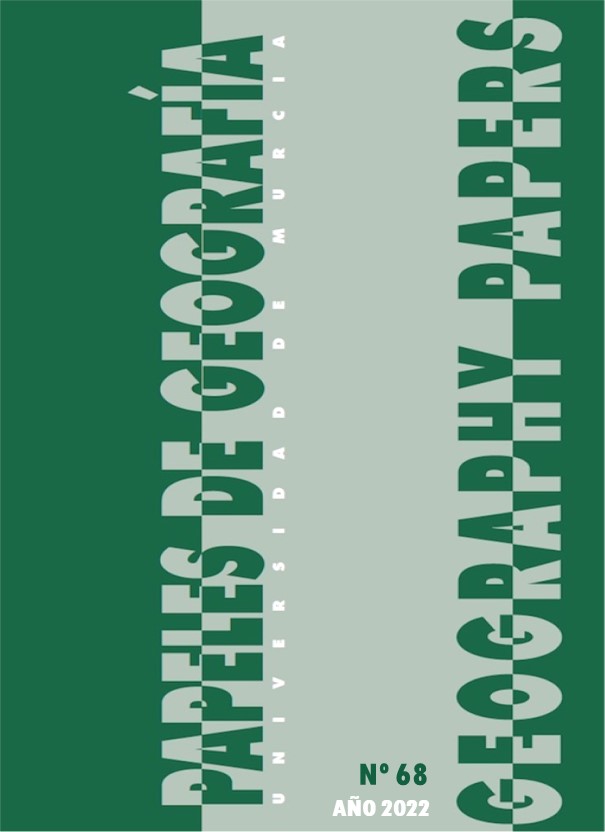CAMBIO DE VEGETACIÓN Y USO DE SUELO DENTRO Y FUERA DEL ÁREA NATURAL PROTEGIDA “EL ZAPOTAL”, CHIAPAS, MÉXICO
Resumen
La reserva “El Zapotal” es el Área Natural Protegida (ANP) poseedora de uno de los últimos fragmentos de Selva Mediana Subperennifolia del Valle Central del estado de Chiapas; allí se distribuyen especies de flora y fauna nativas. Se realizó un estudio espacio-temporal del cambio de vegetación y uso de suelo, analizando imágenes satelitales Landsat de los años 1980, 2000 y 2020. Se registraron sitios con evidencia de extracción de madera, áreas susceptibles a incendios y entradas clandestinas. De acuerdo al análisis de U Mann-Whitney, no existió diferencia significativa (p>0.05) en la cobertura de ninguna de las cuatro clases de vegetación y uso de suelo, dentro y fuera de la ANP a lo largo de los 40 años. No obstante, la Selva Mediana Subperennifolia y el Acahual presentaron una tasa de cambio negativa, al interior y al exterior de “El Zapotal”, mientras que el Suelo Urbano presentó una tasa de cambio positiva en las inmediaciones de la ANP, dando una señal de alarma sobre el proceso de aislamiento de la reserva con respecto a otras áreas de protección de ecosistemas, así como de áreas cubiertas por vegetación nativa.
Descargas
-
Resumen1246
-
PDF689
Citas
AZUELA, A., y MUSSETTA, P. (2009): “Algo más que el ambiente: Conflictos sociales en tres áreas naturales protegidas de México”. Revista de ciencias sociales, vol.1, n°16, p.191-215. https://ridaa.unq.edu.ar/bitstream/handle/20.500.11807/1277/11_RCS-16_miscelaneas2.pdf?sequence=1&isAllowed=y
BRENNER, L. (2006): “Áreas naturales protegidas y ecoturismo: el caso de la Reserva de la Biosfera Mariposa Monarca, México”. Relaciones. Estudios de historia y sociedad, vol. 27, n° 105, p. 237-265. https://www.redalyc.org/pdf/137/13710508.pdf
BAILEY, K. M., MCCLEERY, R. A., BINFORD, M. W., y ZWEIG, C. (2015): “ Land-cover change within and around protected areas in a biodiversity hotspot”. Journal of Land Use Science, vol. 11, n°2, p. 154-176. http://dx.doi.org/10.1080/1747423X.2015.1086905
BOLÍVAR-CIMÉ, B., LABORDE, J., MACSWINEY G., M. C., MUÑOZ-ROBLES, C., y TUN-GARRIDO, J. (2013): “ Response of phytophagous bats to patch quality and landscape attributes in fragmented tropical semi-deciduous forest”. Acta Chiropterologica, vol. 15, n°2, p. 399–409. https://doi.org/10.3161/150811013X679026
CASTILLO, L. S., CORREA AYRAM, C. A., MATALLANA TOBÓN, C. L., CORZO, G., AREIZA, A., SERRANO, F., CHALÁN, L., SÁNCHEZ, F., MORE, A., FRANCO, O., BLOOMFIELD, H., AGUILERA, V. L., RIVADENEIRA, C., MORÓN, V., YERENA, E., PAPADAKIS, J., CÁRDENAS J. J., GOLDEN, R. E., y GODÍNEZ, O. (2020): “ Connectivity of Protected Areas: Effect of Human Pressure and Subnational Contributions in the Ecoregions of Tropical Andean Countries” . Land, vol.9, n°8, p. 2-19. doi:10.3390/land9080239
CASTAÑEDA, J. (2006): “ Las áreas naturales protegidas de México; de su origen precoz a su consolidación tardía”. Scripta Nova, vol. 10, n° 218. http://www.ub.edu/geocrit/sn/sn-218-13.htm
CHANONA, A., CASTELLANOS, J., GONZALES, M., y RANGEL, M. (2017): “ Éxito de Anidación del Turdus grayi (Passeriformes: Turdidae) en el Centro Ecológico Recreativo “El Zapotal”, Chiapas, México” . Revista de Biología Tropical, vol. 65, n° 3, p. 925-938. https://www.scielo.sa.cr/scielo.php?pid=S0034-77442017000300925&script=sci_arttext
COMITÉ ESTATAL DE INFORMACIÓN ESTADÍSTICA Y GEOGRAFÍA [CEIEG]. http://map.ceieg.chiapas.gob.mx/geoweb/ [consulta: 15 de Agosto de 2021]
CONGEDO, L. (2013). Semi-Automatic Classification Pluginfor QGIS. Roma, Universidad Sapienza. http://www.planning4adaptation.org/Docs/papers/Semi-Automatic_Classification_Plugin_for_QGIS.pdf
DÁVALOS, R. (2016): “El papel de la investigación científica en la creación de áreas naturales protegidas”. Madera y bosques, vol. 22, n°1, p. 7-13. http://www.scielo.org.mx/pdf/mb/v22n1/1405-0471-mb-22-01-00007.pdf
FERNÁNDEZ, M. Y. (1998). Contribución al estudio de la Fauna silvestre libre de el Zapotal, Tuxtla Gutiérrez, Chiapas [Tesis de Licenciatura. UNAM].
FERNÁNDEZ, M. Y. (2010). Percepciones ambientales sobre una Reserva Ecológica Urbana, El Zapotal, Tuxtla Gutiérrez, Chiapas [Tesis de Doctorado. ECOSUR].
GÁLVEZ, N., HERNÁNDEZ, F., LAKER, J., GILABERT, H., PETITPAS, R., BONACIC, C., GIMONA, A., HESTER, A., y MACDONALD, D.W. (2013): “ Forest cover outside protected areas plays an important role in the conservation of the Vulnerable guiña (Leopardus guigna)”. Oryx , vol. 47, n° 2, p. 251-258. doi:10.1017/S0030605312000099
GARCÍA, G., SOSA, J. E., AGUILAR, W. D. J., FLORES, J. S., y FERNÁNDEZ, Y. (2020): “ Cambio de uso del suelo en la Zona Sujeta a Conservación Ecológica Reserva Cuxtal, Mérida, Yucatán, México”. Investigaciones geográficas, vol. 101, p. 1-15. Doi: 10.14350/rig.59895
GIZACHEW, B., RIZZI, J., SHIRIMA, D. D., y ZAHABU, E. (2020): “Deforestation and connectivity among protected areas of Tanzania”. Forests, vol. 11, n° 2, p. 2-16. doi:10.3390/f11020170
GOETZ, S. J., JANTZ, P., y JANTZ, C. A. (2009): “ Connectivity of core habitat in the Northeastern United States: Parks and protected areas in a landscape context”. Remote Sensing of Environment, vol. 113, n° 7, p. 1421-1429. https://doi.org/10.1016/j.rse.2008.07.019
GUERRA, C. A., ROSA, I. M., y PEREIRA, H. M. (2019): “Change versus stability: are protected areas particularly pressured by global land cover change?”. Landscape Ecology, vol. 34, p. 2779-2790. https://doi.org/10.1007/s10980-019-00918-4
HERNÁNDEZ-RIVERA, M. G., y TORRES-HERNÁNDEZ, L. (2015): “Análisis de dos áreas naturales protegidas en relación con el crecimiento del Área Metropolitana de Xalapa, Veracruz”. Investigaciones Geográficas, Boletín del Instituto de Geografía, vol. 87, p. 51–61. https://doi.org/10.14350/rig.39077
HOLLANDER, M., WOLFE, D. A., y CHICKEN, E. (2015): Nonparametric Statistical Methods. John Wiley&Sons, Ltd.
INSTITUTO NACIONAL DE ESTADÍSTICA, GEOGRAFÍA E INFORMÁTICA [INEGI]. https://www.inegi.org.mx/app/geo2/elevacionesmex/ [consulta: 20 de Agosto de 2021]
JASSO-DEL TORO, C., MÁRQUEZ-VALDELAMAR, L. y MONDRAGÓN-CEBALLOS, R. (2016): “Genetic diversity in Mexican mantled howler monkeys (Alouatta palliata mexicana) at the Reserva de la Biosfera Los Tuxtlas (Veracruz, Mexico)”. Revista Mexicana de Biodiversidad, vol. 87, p. 1069-1079.
MAPELLI, F. J., MORA, M. S., MIROL, P. M., y KITTLEIN, M. J. (2012): “Population structure and landscape genetics in the endangered subterranean rodent Ctenomys porteousi”. Conservation Genetics, vol. 13, n°1, p. 165–181. https://doi.org/10.1007/s10592-011-0273
MORERA, C., SANDOVAL, L. F., y ALFARO, L. D. (2021): “Evaluación de corredores biológicos en Costa Rica: estructura de paisaje y procesos de conectividad-fragmentación”. Revista Geográfica de América Central, vol. 66, p.106-132. https://dx.doi.org/10.15359/rgac.66-1.5
OLMOS, E., y GONZÁLEZ, M. E. (2011): “Estrategias de desarrollo local sustentable en un área natural protegida de Baja California Sur”. Universidad y Ciencia, vol. 27, n°3, p. 281-298. http://www.scielo.org.mx/scielo.php?script=sci_arttext&pid=S0186-29792011000300004
OSORIO, M., MAASS, S. F., RAMÍREZ I. L., NAVA, G., NOVO, G., y REGIL, H. H. (2011): “El visitante del Parque Nacional Nevado de Toluca, México. Análisis del comportamiento en un área natural protegida”. Investigaciones geográficas, vol. 76, p. 56-70. https://bit.ly/3flRDNc
OJEDA, J., y VILLAR, A. (2007). “Evolución del suelo urbano/alterado en el litoral de Andalucía. GeoFocus”. Revista Internacional de Ciencia y Tecnología de la Información Geográfica, vol.7, p. 73-99. http://geofocus.org/index.php/geofocus/article/viewFile/112/274
PÉREZ, J. C., GUÍZAR, F., y BELLO, E. (2018): “Conflicto territorial, ecoturismo y cacería no regulada: el traslape de territorialidades en el Área Natural Protegida de Balam-Kú”. PASOS Revista de Turismo y Patrimonio Cultural, vol. 16, n°4, p. 909-925. https://doi.org/10.25145/j.pasos.2018.16.064
PLAZOLA, L., SÁNCHEZ, F. J. S., SÁNCHEZ, J. A., y ROMERO, E. S. (2020): “Valoración de los servicios ecosistémicos en áreas verdes. El caso del Parque Metropolitano de Guadalajara, México”. Acta Universitaria, vol. 30, p. 1–17. https://doi.org/10.15174/au.2020.2635
QGIS.ORG. http://www.qgis.org [consulta: 05 de Julio de 2021]
R CORE TEAM. http://www.R-project.org/ [consulta: 20 de Junio de 2021]
RIEMANN, H., SANTES-ÁLVAREZ, R. V., y POMBO, A. (2011): “El papel de las áreas naturales protegidas en el desarrollo local: El caso de la península de Baja California”. Gestión y política pública, vol. 20, n°1, p. 141-172. http://www.scielo.org.mx/pdf/gpp/v20n1/v20n1a4.pdf
RODRÍGUEZ, M., SÁNCHEZ, J., GÓMEZ, B.(2019): “Escarabajos Coprófago (Coleoptera: Scarabaeidae: Scarabaeinae) en la Reserva El Zapotal, Chiapas, México”. Revista Peruana de Biología, vol. 26, n°3, p. 339-350. http://dx.doi.org/10.15381/rpb.v26i3.16778
ROJAS BRICEÑO, N. B., BARBOZA CASTILLO, E., MAICELO QUINTANA, J. L., OLIVA CRUZ, S. M., y SALAS LÓPEZ, R. (2019): “Deforestaciónen la Amazonía peruana: Índices de cambios de cobertura y uso del suelo basado en SIG”. Boletín de la Asociación de Geógrafos Españoles, vol. 81, n°2538, p. 1-34. https://doi.org/10.21138/bage.2538a
RSTUDIO TEAM. http://www.rstudio.com/ [consulta: 20 de Junio de 2020].
SAHAGÚN, F., J. y REYES, H. (2018): “Impactos por cambio de uso de suelo en las áreas naturales protegidas de la región central de la Sierra Madre Oriental, México”. Ciencia UAT, vol. 12, n°2, p. 06-21. http://www.scielo.org.mx/scielo.php?script=sci_arttext&pid=S2007-78582018000100006
SANTIZO, L. (2019). Efecto de la composición y configuración espacial del paisaje sobre la diversidad de anfibios y reptiles de la Selva El Ocote, Chiapas [Tesis de Maestría]. Universidad de Ciencias y Artes de Chiapas.
SECRETARÍA DE MEDIO AMBIENTE E HISTORIA NATURAL [SEMAHN]. https://www.semahn.chiapas.gob.mx/portal/danvs/anp [consulta: 10 de Junio de 2020]
SECRETARÍA DE MEDIO AMBIENTE E HISTORIA NATURAL [SEMAHN]. (2013). Programa de Manejo del Centro Ecológico Recreativo “El Zapotal”. Recuperado de https://sistemaestatalambiental.chiapas.gob.mx/fraccionI.html
SERVICIO GEOLÓGICO DE LOS ESTADOS UNIDOS [USGS]. https://earthexplorer.usgs.gov/ [consulta: 25 de Agosto de 2021]
SOSA, J., SOLÍS, A. B., SIERRA, C. L. J., DÁVALOS, L. I. Í., y ORTEGA-RUBIO, A. (2014). “Manejo del área natural protegida Sierra Fría, Aguascalientes: situación actual y desafíos”. Investigación y ciencia, vol. 22, n°60, p. 71-77. https://www.redalyc.org/pdf/674/67431160009.pdf
TOLEDO, V. M. (2005): “Repensar la conservación: ¿áreas naturales protegidas o estrategia bioregional?”. Gaceta ecológica, vol. 77, p. 67-83. https://www.redalyc.org/pdf/539/53907705.pdf
VILLEGAS, D., y GÓMEZ, W. (2020): “Procesos locales de transformación que detonan el cambio de uso de suelo y vegetación en un área natural protegida de la Región Centro de México”. Acta universitaria, vol. 30, p. 1-21. https://doi.org/10.15174/au.2020.2864
VILLALOBOS, I. (2000): “Áreas naturales protegidas: instrumento estratégico para la conservación de la biodiversidad”. Gaceta Ecológica, vol. 54, p. 24-34. https://www.redalyc.org/pdf/539/53905402.pdf
- 25-01-2023 (2)
- 11-04-2022 (1)
Derechos de autor 2022 Papeles de Geografía

Esta obra está bajo una licencia internacional Creative Commons Atribución-NoComercial 4.0.
Las obras que se publican en esta revista están sujetas a los siguientes términos:
1. El Servicio de Publicaciones de la Universidad de Murcia (la editorial) conserva los derechos patrimoniales (copyright) de las obras publicadas, y favorece y permite la reutilización de las mismas bajo la licencia de uso indicada en el punto 2.
2. Las obras se publican en la edición electrónica de la revista bajo una licencia Creative Commons Reconocimiento-NoComercial 4.0 (texto legal). Se pueden copiar, usar, difundir, transmitir y exponer públicamente, siempre que: i) se cite la autoría y la fuente original de su publicación (revista, editorial y URL de la obra); ii) no se usen para fines comerciales; iii) se mencione la existencia y especificaciones de esta licencia de uso.
3. Condiciones de auto-archivo. Se permite y se anima a los autores a difundir electrónicamente las versiones pre-print (versión antes de ser evaluada) y/o post-print (versión evaluada y aceptada para su publicación) de sus obras antes de su publicación, ya que favorece su circulación y difusión más temprana y con ello un posible aumento en su citación y alcance entre la comunidad académica. Color RoMEO: verde.








